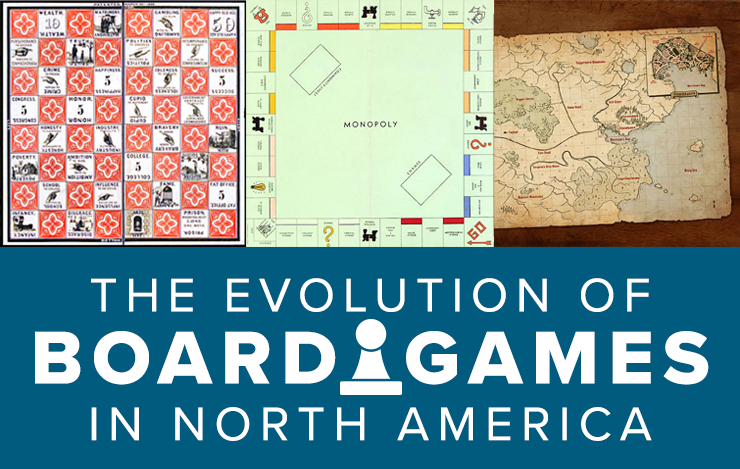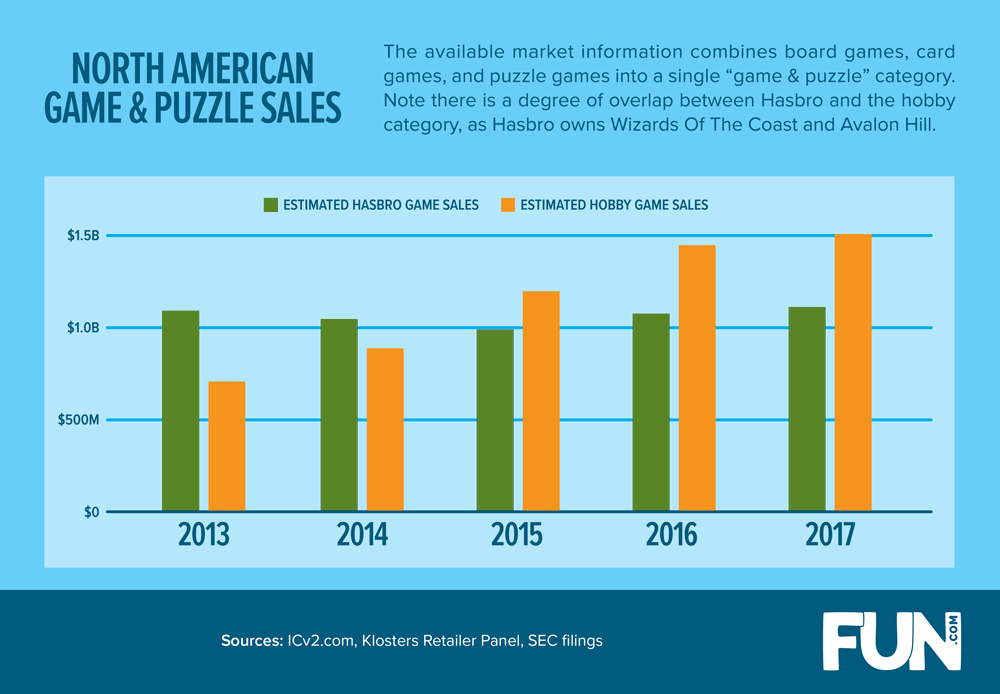It’s 2018 and we’re in the midst of a board games renaissance. We take it for granted that games released today will be designed by professionals, refined through playtesting, and enjoyed by a wide variety of players. In many ways, they’re much like Hollywood blockbusters backed by the power of market research and test audiences.
Of course, this doesn’t mean that everything released before The Settlers of Catan in 1996 is an unplayable disaster! Ancient pastimes like the Royal Game of Ur, Backgammon, and Chess influenced early American games from Monopoly to Risk, which in turn led to Catan and Pandemic. So it’s about time that we look back at how North American board games have evolved, from The Travellers Tour Through the United States through Gloomhaven. We also show how game and puzzle sales continue to increase every year.
Click Images for Larger View
“I only play RISK on a custom Goode homolosine map projection board” said no one ever. Okay, let’s be real, probably like a room full of cartographers have said that.
Embed This Image on Your Site:
The Evolution of Board Games in North America Transcription
Before America
Board games might be as old as the written word. Archeologists have found boards that date back to Ancient Egypt, even though the rules for many of them have been lost to time. Other games have seen their rules shift and change over centuries. What does it take to be remembered?
The Royal Game of Ur: 31st Century BC
The oldest board game we have a near-complete set of rules for is a game archeologists named The Royal Gale of Ur. Thanks to ancient tablets, we know it involved players racing each other to the end of the board using dice. Unfortunately, we don't know the exact path players took, nor the game's actual name.
Backgammon: 6th Century AD
Originating as a Persian game called Nard—a possible relative to Ur—its names and rules evolved over numerous centuries. A scoring system to enable gambling was added in 18th century England, where it was renamed Backgammon. You might know it best as that game on the other side of the checkerboard.
Chess: 6th Century AD
Every piece could only move one space in the original game from India. Each kingdom it spread to changed a few details, until the game was standardized for international play in 1849. In the meantime, a 12th century French player set Backgammon pieces on a chessboard to invent what became Checkers.
In America
The Travellers Tour Through the United States
1822 | F. & R. Lockwood
Designer: Unknown
The earliest known board game published in the US was a simple map game, likely inspired by similar games from England. Dice were frowned upon for children's games due to their association with gambling, so movement was instead determined by using a teetotum—a spinning top with numbers.
The Mansion of Happiness
1843 | W. & S.B. Ives
Designer: George Fox
Racing to the center of the spiral was a genre popularized by Game of the Goose, a 16th-century Italian game. Mansion of Happiness was a hit in England in 1800, where the trend was games that revolved around religious morals and values. When published in the US, it kicked off an industry here.
The Checkered Game of Life
1860 | Milton Bradley
Designer: Milton Bradley
Inspired by The Mansion of Happiness and sudden inactivity at his printing company, Milton Bradley designed and printed his own morality-based board game. In an unusual move, the teetotum was used to determine which directions you could move in, with the end goal of reaching "Happy Old Age".
Parcheesi
1867 | Selchow & Righter (as E.G. Selchow & Co.)
Designer: Unknown
Parcheesi was the US name for Parchisi, a 16th century game from India. it was trademarked by E.G. Selchow & Co. in 1874, but was first published sometime earlier. It led to simplified versions such as Sorry! in 1934 from Parker Brothers and Trouble in 1965 from Irwin Toy Co. and Milton Bradley.
Games of the Pilgrim's Progress, Going to Sunday School and Tower of Babel
1875 | McLoughlin Brothers
Designer: Unknown
Dice were becoming less taboo but still didn't seem very appropriate for very young children. This led to the creation of the first spinner by the McLoughlin Brothers, who were the market leader at the time. They called it the Indicator, and it came packed in with children's' games or could be bought separately.
The Amusing Game of Innocence Abroad
1888 | Parker Brothers
Designer: Mrs. Shepherd
The first board game released under the name Parker Brothers (previously Geo S. Parker), Innocence Abroad combines the three most common board types of the time: the spiral road, the map game, and the checkerboard. By unraveling a spiral to fit on a map, it might have introduced the first winding road board.
Monopoly
1933 | Chas B. Darrow, 1935 | Parker Brothers
Designer: Elizabeth "Lizzie" Magie, et al.
Monopoly began as The Landlord's Game, a lesson about income equality created in 1903. For decades friends made copies for their friends, sometimes with customizations, until it was spotted by Parker Brothers. By then it had become a great game called Monopoly, with the political message lost on its players.
Chutes and Ladders
1943 | Milton Bradley
Designer: Unknown
Like Parcheesi, Chutes and Ladders came from India. Players moved along a checkered board trying to land on ladders (virtues) and avoid snakes (vices), which made it easy to adapt into an English morality game circa 1892. Milton Bradley removed the morality and replaced the snakes with slides.
Scrabble
1948 | Prod. & Marketing, 1953 | Selchow & Righter
Designer: Alfred M. Butts
Games involving forming words out of letter tiles go back as far as the 19th century with games like Anagrams, but Scrabble added two important innovations: assigning a score to each letter, and including a crossword-inspired board to place the words on. The initial publisher couldn't keep up with orders.
Clue
1949 | Parker Brothers
Designer: Anthony E. Pratt
British board game company Waddingtons named the game Cluedo, a reference to the popular game Ludo. but in America, Ludo was known as Parcheesi, so the Parker Brothers renamed it Clue. A movie adaption starring Tim Curry was released in 1985, the first film based on a board game.
Candy Land
1949 | Milton Bradley
Designer: Anthony E. Pratt
Candy Land could be played by young kids who hadn't yet learned to count because movement was determined by color. but when previous games did it, they ended up forgotten, like Pilgrim's Progress (mentioned earlier). Was candy the secret ingredient that lodged the game in everyone's memory?
Hex
1952 | Parker Brothers
Designer: Piet Hein or John Nash
The earliest known game to use a grid of hexagons is an 18th-century French game called Agon, and the first one published in the US was Office Boy from 1889, but Hex is notable because it inspired Rand Corporation to replace squares with hexagons on their maps used for war games by the military.
Tactics
1954 | Avalon Hill (as Avalon Game Company)
Designer: Charles S. Roberts
Military use of war games dates back to 1810 and Kriegsspiel. Charles S. Roberts had heard of these games but wasn't sure where to find them, so he made his own. His company Avalon Hill became a favorite among war game hobbyists. He started using hex grids in 1961 after seeing Rand was doing it.
Risk
1959 | Parker Brothers
Designer: Albert Lamorisse
Risk began as a 1957 French game called La Conquête du Monde, but Parker Brothers adjusted the rules so the game would play faster. Compared to other more complex war games, the ease and quickness of play gave Rish greater mass appeal, making it one of the most popular military board games.
Diplomacy
1959 | Allan Calhamer, 1961 | Games Research
Designer: Allan B. Calhamer
Diplomacy was the polar opposite of Risk, a complex and lengthy game that was entirely strategy and no dice. It gained a cult following, but in the days before the internet it wasn't so easy to find opponents to play. Fanzines helped to organize matches played by mail, similar to Chess pen pals.
The Game of Life
1960 | Milton Bradley
Designer: Reuben Klamer
On the 100th anniversary of The Checkered Game of Life, the game was completely redesigned and updated for the times. Now instead of reaching "Happy Old Age", the goal was to become the wealthiest player. The game board was enhanced with molded plastic pieces to make it stick out.
Mouse Trap
1963 | Ideal
Designer: Marvin Glass, Burt Meyer, et al.
Toy designer Marvel Glass & Associates took plastic game boards one step further, creating a Rube Goldberg machine that blurred the line between toy and game. They pitched it to Ideal, a toy company who didn't consider themselves a game company, but Mouse Trap instantly made them the third-largest.
Battleship
1967 | Milton Bradley
Designer: Unknown
Based on an old pencil-and-paper game known by various names but first published as Salvo in 1931, Battleship replaced the hand-drawn rectangles and Xs with plastic ships and pegs on a plastic peg board. The upper half sat at a 90-degree angle so you could shield your opponent from peeking.
Connect Four
1974 | Milton Bradley
Designer: Howard Wexler & Ned Strongin
Connect Four also had a vertical board, and played like a mix of Tic-Tac-Toe and Checkers. Milton Bradley published numerous plastic concepts that challenged the definition of "board game", including Operation in 1965, Hungry Hungry Hippos in 1978, and card/board hybrid Guess Who? in 1979.
Dungeons & Dragons
1974 | TSR
Designer: Gary Gygax & Dave Arneson
From the world of war games came an idea so innovative that it spawned its own genre. Although the board was typically created by the player, a simplified board game edition for beginners was released in 1991 as The New Easy to Master Dungeons & Dragons.
Trivial Pursuit
1981 | Horn Abbot, 1982 Selchow & Righter
Designer: Scott Abbot & Chris Haney
Board games were typically considered something for families or for hobbyists, with very few options for party games for adults. There'd been previous trivia board games, but Trivial Pursuit's secret weapon was asking pop culture questions to the first generation of adults who'd been raised on television.
Renaissance
The 20th-century history of the US board game industry played out like a real-life game of Monopoly, with companies buying each other up until only one remained. Innovation stagnated, and so did interest in board games. But then smaller companies began to introduce new ideas...
- 1920: Milton Bradley bys McLoughlin Brothers
- 1984: Hasbro buys Milton Bradley
- 1986: Coleco buys Selchow & Righter
- 1989: Hasbro buys Coleco
- 1991: Hasbro buys Parker Brothers
- 1994: Hasbro buys Waddingtons
- 1997: Wizards of the Coast buys TSR
- 1998: Hasbro buys Avalon Hill
- 1999: Hasbro buys Wizards of the Coast
The Settlers of Catan
1996 | Mayfair Games
Designer: Klaus Teuber
Settlers of Catan introduced Americans to German "Euro-style games", which focused more on strategy than luck, yet weren't as lengthy or complex as war games. Catan was a game that both hobbyists and their families could enjoy, and by 2013 it had become the fourth-largest board game brand in the US.
Carcassonne
2000 | Rio Grande Games
Designer: Klaus-Jürgen Wrede
Both Catan and Carcassonne used boards made of tiles so the game played differently every time, but the latter made tile placement part of the game. Published in the US by Rio Grande Games, a company founded by former Mayfair Games employee Jay Tummelson, it became another strategy hit.
Ticket to Ride
2004 | Days of Wonder
Designer: Alan R. Moon
Ticket to Ride completed the triad of Euro-style games that acted as a gateway to players seeking out slightly more advanced games. Downloadable app versions of games were also responsible for converting people into new board game fans, as was the YouTube series TableTop starting in 2012.
Twilight Struggle
2005 | GMT Games
Designer: Ananda Gupta & Jason Matthews
In contrast to German games, which typically avoid the subject of war, Twilight Struggle was designed as a war game intended to be easier and faster to play. The resulting game spent a record five years in the #1 spot on BoardGameGeek, a site that's been bringing together board game fans since 2000.
Pandemic
2007 | Z-Man Games
Designer: Matt Leacock
Pandemic was designed to be the opposite of a war game. Instead of battling players for control of the world, you worked together to try and save it. Like other successful strategy series, it's had a number of expansions and spin-offs, and is currently experimenting with a story-driven season-based format.
The Gentlemen of the South Sandwiche Islands
2010 | Taylor & Gray
Designer: James Taylor
Kickstarter was founded in April 2009, and it changed board games forever. One game in 2013 raised $12.3 million. Yet very few remember the first board game to be successfully Kickstarted, which reached its humble goal in February 2010 to print 500 copies, shipped in August 1020, and was quietly forgotten.
Alien Frontiers
2010 | Clever Mojo Games
Designer: Tory Niemann
The first big hit game to come out of Kickstarter raised $14k toward its goal of $5k in June 2010 and shipped in October 2010. It led to additional Kickstarter campaigns that funded an expansion, and app, and additional printings, each one of them more successful than the first one.
XCOM: The Board Game
2014 | Fantasy Flight Games
Designer: Eric M. Lang
As smartphones became more commonplace, companion apps for board games began to appear, which sped up and simplified complex aspects of games, or were just a little more convenient. XCOM was the first board game that required downloading a free companion app in order to play it.
Gloomhaven
2017 | Cephalofair Games
Designer: Isaac Childres
Gloomhaven ranks #1 on BoardGameGeek, a position it's held since December 2017. It initially raised $386k on Kickstarter, but gained so much positive buzz via word of mouth that a second campaign for an additional print run raised nearly $4 million. It's one of the heftier board games around, weighing in at 20lbs.
Sources: BoardGameGeek.com, Euromonitor.com, Kickstarter.com, MuseumOfPlay.org, TheBigGameHunter.com, RAND.org, It's All A Game: The History of Board Games from Monopoly to Settlers of Catan
North American Game & Puzzle Sales
It’s interesting to see how hobby game sales in general have increased every year while Hasbro sales have remained steady. Poor Hasbro! (We kid. At $1B sales per year, they’re doing quite well.)
Embed This Image on Your Site:
Did we mention your favorite game? If we skipped anything, let us know what (and why) in the comments below. Maybe consider picking up a fun game for a friend! Also, we humbly apologize for that cartography joke. Was it even a joke? Let’s hear your opinion about that in the comments, too.
Infographic Designed and Illustrated by Kate Willaert
 Blog Home
Blog Home Artwork
Artwork Gift Guides
Gift Guides Infographics
Infographics Printable Crafts
Printable Crafts Resources
Resources Tutorials
Tutorials Contests
Contests Costumes
Costumes Quizzes
Quizzes Recipes
Recipes
![The Evolution of Board Games in North America [Infographic]](https://images.fun.com/infographics/the-evolution-of-board-games-in-north-america-infographic.png)

